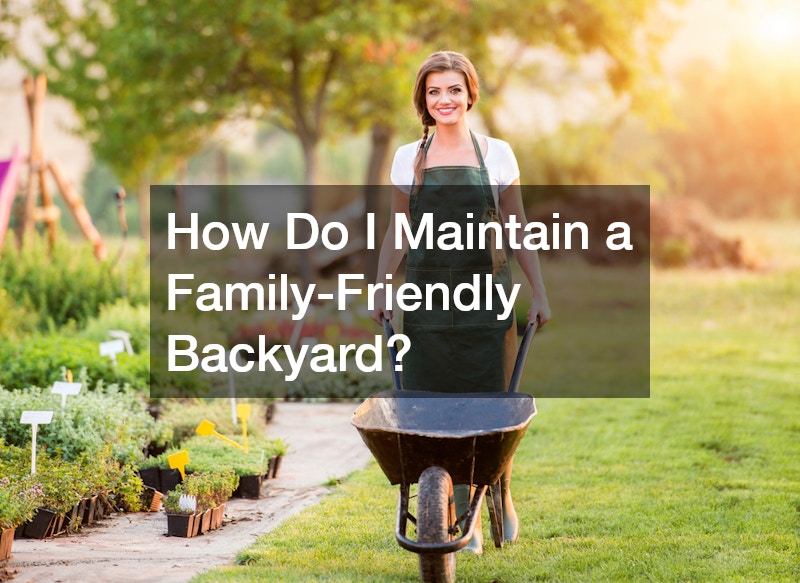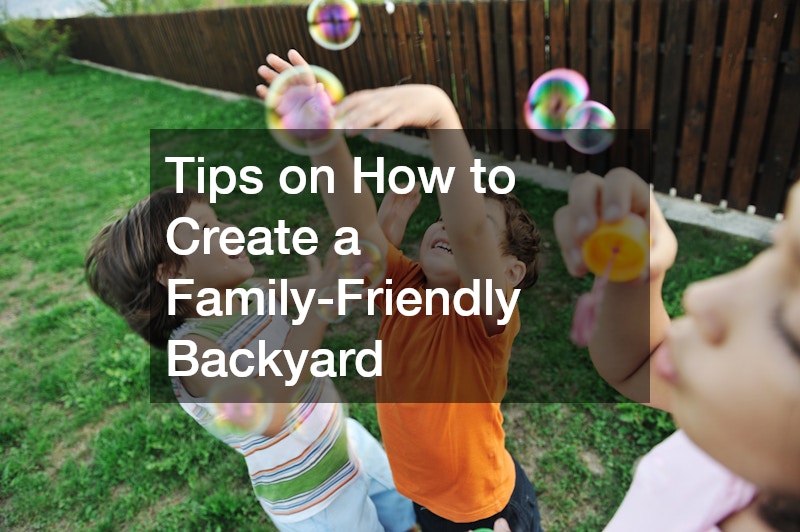A backyard is more than just outdoor space—it can be the heart of your home, where families bond, children explore, and memories are made under open skies. Designing a family-friendly backyard requires thoughtful planning that takes into account safety, functionality, and enjoyment for people of all ages. Whether you’re working with a small lawn or a large estate, the right combination of features can transform your yard into a welcoming oasis for relaxation, play, and togetherness. This article explores creative, practical, and budget-conscious tips to help you create the ideal backyard space, while also addressing safety measures, sustainable options, and maintenance solutions.
What Are the Essential Features of a Family-Friendly Backyard?

Functional Play Areas for Children
Children thrive in outdoor environments that offer variety and stimulation. Consider setting up designated play zones with swing sets, climbing walls, or mini-obstacle courses. These areas should be age-appropriate and offer enough room for active play. Hiring a local concrete contractor can help you create smooth, safe surfaces for basketball courts or chalk drawing spaces, ensuring durability while minimizing tripping hazards.
If you want to go beyond traditional playground equipment, you might explore nature-based play. Use logs, stumps, or even repurposed boulders from a tree company to craft climbing elements that blend into the natural environment. This makes your space both visually appealing and physically engaging.
Comfortable Seating for Adults
While the kids are occupied with play, adults should also have an area to relax. Comfortable seating areas, whether under a pergola or beside a fire pit, can be arranged with weather-resistant outdoor furniture and accent tables. Use a landscape lighting company to install subtle but effective lighting, allowing the space to remain functional and inviting after sunset. This not only enhances the ambiance but also ensures safety as daylight fades.
Seating areas should be located near children’s play zones for easy supervision while still giving adults their own space to unwind, read a book, or socialize.
Safe and Accessible Design
Accessibility is key when designing a family-friendly yard. Paved walkways should be wide enough for strollers or wheelchairs, and transitions between surfaces should be smooth and gradual. A local concrete contractor can help you pour walkways or patios that are both durable and visually cohesive with the rest of your landscaping.
If you have utilities like a septic system in your yard, make sure access points are clearly marked but safely secured, especially if children are frequently outdoors. It’s a good idea to coordinate with a plumber to ensure all plumbing fixtures and lines are safely placed and maintained to avoid any hidden hazards.
How Can I Incorporate Safety into My Backyard Design?
Childproof Fencing and Gates
One of the most critical elements in a child-friendly yard is proper fencing. Installing a vinyl fence offers a safe, durable, and low-maintenance solution for enclosing your yard. Vinyl fencing resists splintering and does not require frequent repainting or sealing, making it ideal for families with children and pets.
Strategically placed gates should have childproof locks and easy access for adults. If your backyard borders a wooded area or a body of water, fencing becomes even more essential for safety.
Non-toxic and Safe Plant Choices
The beauty of landscaping shouldn’t come at the expense of your family’s health. Select non-toxic plants that won’t pose a risk to curious children or pets. Avoid thorny or spiky plants that could cause injury during play. Consulting a lawn care services provider can help you identify safe grasses and plants that will thrive in your specific climate and soil conditions.
Incorporate raised garden beds or vertical gardening walls to introduce greenery in ways that also discourage trampling and allow easier monitoring.
Installing Soft Surfaces in Play Areas
Installing shock-absorbing surfaces beneath swings, jungle gyms, or climbing structures is a key safety consideration. Rubber mulch, synthetic turf, or padded outdoor tiles can significantly reduce the risk of injury from falls. These materials are typically weather-resistant and easy to clean, making them a practical option for families.
You might also want to enlist the help of a land surveyor to ensure all play structures are installed on even ground, reducing the likelihood of shifting or tipping due to sloped terrain.
What Are Some Kid-Friendly Landscaping Tips?
Creating Interactive Garden Spaces
Gardening can be an excellent learning experience for kids. Set up an interactive garden with small plots for flowers, herbs, or vegetables. This not only fosters responsibility but also sparks curiosity about nature and science. Raised beds or large pots can make it easier for small hands to dig, plant, and harvest.
You can make the experience even more engaging by adding whimsical elements like painted rocks, miniature fairy houses, or bug hotels, all of which promote exploration and creativity.
Paths and Trails for Exploration
Adding small pathways or trails can give children their own mini-adventures in the yard. Winding paths made from mulch, gravel, or stamped concrete create areas for kids to explore safely on bikes or foot. A local concrete contractor can help design custom paths with interesting patterns or embedded stones for tactile variety.
Place benches, garden art, or hidden treasures along these trails to encourage discovery and make the walk exciting.
Shade Solutions for Protection
A well-shaded yard protects against harmful UV rays and keeps play areas cool during hot summer months. Shade can be provided naturally with tall trees installed by a professional tree company or created artificially using pergolas, umbrellas, or shade sails.
Planting deciduous trees is particularly effective—they provide full shade in summer and let sunlight through in winter. This dual benefit ensures year-round comfort and energy efficiency.
How Can I Design a Versatile Space for Different Family Activities?

Flexible Furniture Arrangements
Invest in lightweight, modular furniture that can be easily rearranged based on your needs. A weekend birthday party may require more open space, while a weeknight dinner might call for a cozy table setting. Cushioned benches, stackable chairs, and collapsible tables are great for accommodating changing uses of the space.
Consider materials that are both stylish and functional—look for weatherproof coatings and quick-dry cushions that hold up against the elements and frequent use.
Multi-purpose Lawn Areas
Large grassy areas serve as blank canvases for games, gatherings, and impromptu picnics. Lawn care services can ensure your grass remains lush and well-maintained. Opt for hardy grass types that can withstand high foot traffic without wearing out.
You can also incorporate discreet boundary markers or stone edging from a masonry company to segment your lawn from garden beds or paved patios, helping organize the space without reducing its flexibility.
Outdoor Cooking and Dining Spaces
An outdoor kitchen or grilling station encourages more family meals outside. Include a built-in grill, mini-fridge, and ample countertop space for food prep. Work with a plumber to ensure any gas or water lines are safely installed, and don’t forget about weatherproof storage for utensils and cookware.
Set up a dining area under a canopy or pergola to protect against sun and light rain. Add a few string lights from a landscape lighting company for ambiance during evening meals.
What Are the Best Materials to Use for a Family-Friendly Backyard?
Durable and Low-maintenance Surfaces
When it comes to flooring and hardscaping, durability is paramount. Concrete, brick, and pavers installed by a masonry company provide long-lasting, slip-resistant surfaces that can withstand the wear and tear of an active family.
Opt for materials that require minimal upkeep—sealed concrete or composite decking, for example, can be easily hosed down or swept clean.
Eco-friendly Materials
Look for recycled, reclaimed, or sustainable materials wherever possible. Composite lumber made from recycled plastic and wood fibers offers the look of natural wood without the maintenance. Recycled rubber pavers are another great option for patios or walkways, combining sustainability with shock absorption.
If you’re planning a major remodel, consider working with a land surveyor to develop an environmentally conscious layout that optimizes natural water flow and minimizes runoff.
Weather-resistant Options
Outdoor conditions can be unpredictable. Choose furniture, fabrics, and building materials that hold up to sun, rain, and wind. Vinyl fencing is a standout choice for boundaries, offering both durability and resistance to moisture and pests.
Weather-resistant fabrics for cushions and umbrellas ensure they last through the seasons, reducing the need for frequent replacements.
How Should I Address Privacy Concerns?
Strategically Placed Shrubs and Trees
Planting trees and shrubs along property lines can create a natural barrier that enhances privacy while also contributing to the overall landscape design. A tree company can help you select fast-growing species like arborvitae or Leyland cypress to quickly fill in gaps.
Layered plantings—tall trees in the back, medium shrubs in the middle, and smaller plants in front—provide a soft and attractive alternative to solid walls.
Building Fences and Privacy Screens
Fencing remains one of the most effective ways to create a private retreat. Vinyl fences are low-maintenance, come in various styles and colors, and are built to last. For added charm, attach hanging planters or climbing vines to fencing sections.
You can also add standalone privacy screens near patios or play areas. These can be made of wood, metal, or even living walls planted with climbing greenery.
Using Pergolas and Canopies
Pergolas can be outfitted with flowing curtains, retractable canopies, or hanging plants to provide both shade and seclusion. Position these structures over seating or dining areas to carve out distinct zones within the yard.
If you’re unsure about placement, a land surveyor can help you determine optimal locations that preserve property lines and make the best use of space.
What Are Some Innovative Play Equipment Ideas?

Natural Play Structures
Natural materials offer a more organic look and feel to play equipment. Use logs, climbing rocks, and tree stumps to create an adventure zone that blends seamlessly into your yard. These structures promote physical activity and imaginative play while reducing the need for brightly colored plastic equipment.
A tree company can help you identify safe and healthy ways to incorporate existing trees into climbing or swing setups.
Incorporating Water Features
A shallow splash pad or interactive water table can be a refreshing feature in summer months. Always work with a licensed plumber to ensure water lines are properly installed and that all safety measures are followed to prevent leaks or damage to your septic system.
Features like fountains or small streams also enhance the calming ambiance of the space, making it enjoyable for all ages.
DIY Adventure Zones
Build obstacle courses or scavenger hunt trails using household items and repurposed materials. With a little creativity and a few supplies from a home improvement store, you can construct tire tunnels, balance beams, or even a mini climbing wall.
Involve your children in the creation process—it builds excitement and a sense of ownership over the outdoor space.
How Can I Incorporate Sustainability Into My Backyard?
Installing a Rainwater Harvesting System
Collecting rainwater reduces dependence on municipal water systems and provides a sustainable source for garden irrigation. A plumber can help set up downspout diverters and storage tanks connected to hose spigots or irrigation systems.
Ensure proper drainage is in place to protect your septic system and prevent overflow during heavy rains.
Choosing Native Plants
Native plants are more likely to thrive in your region’s climate and require less watering and care. They also attract pollinators and support the local ecosystem. Lawn care services familiar with local flora can guide you toward the best choices for your yard.
Native ground covers can even reduce the need for mowing and fertilizing, lowering your long-term maintenance efforts.
Composting and Recycling Practices
Set up a composting system for kitchen scraps and garden waste. Not only does it reduce landfill use, but it also produces rich, nutrient-dense soil that benefits your garden. Use recycled materials for garden borders, seating, or decor to further reduce your environmental impact.
Getting children involved in composting teaches them about sustainability and the importance of caring for the environment.
What Budget-Friendly Tips Can Help in Creating a Family-Friendly Backyard?
Repurposing Materials
Old pallets, unused bricks, and salvaged wood can be turned into furniture, raised garden beds, or decorative accents. A masonry company may offer leftover materials at reduced prices for small-scale projects.
Repurposing reduces waste and adds a creative, custom touch to your yard.
DIY Landscaping Projects
Simple projects like planting flower beds, building a sandbox, or installing stepping stones can be tackled on weekends. Hiring lawn care services for major upkeep lets you focus on creative additions and personal touches without sacrificing quality.
With help from a land surveyor, you can confidently lay out DIY installations that respect property lines and maintain structural integrity.
Prioritizing Essential Features
Start with core features like play zones, shaded seating, and safe fencing, then build out as your budget allows. Focus on multi-use spaces and durable materials to maximize value over time.
How Do I Maintain a Family-Friendly Backyard?

Regular Cleaning and Upkeep
Frequent maintenance ensures your yard remains safe and inviting. Clear debris, sweep walkways, and sanitize play equipment regularly. Coordinate with a plumber and septic specialist to ensure systems remain in good condition and don’t pose any hidden hazards.
Seasonal Maintenance Checklists
Prepare your yard for each season with a tailored checklist. In spring, plant new flowers and clean gutters. In fall, rake leaves and check for drainage issues. Engage lawn care services to aerate soil, fertilize, or reseed as needed.
Engaging Family in Garden Activities
Assign age-appropriate garden chores to family members. Children can water plants, gather compost, or pick vegetables. Shared activities promote responsibility and encourage everyone to take pride in the backyard space.
Conclusion
Creating a family-friendly backyard is about more than just aesthetics—it’s about crafting a space where every family member can feel at home, whether they’re swinging from monkey bars, sipping lemonade under the pergola, or stargazing around a firepit. By incorporating practical features, engaging play elements, and sustainable solutions, you can transform your outdoor area into a safe, functional, and joyful retreat. With thoughtful planning and the support of professionals such as a landscape lighting company, tree company, or plumber, your backyard can become the vibrant heart of your home.
